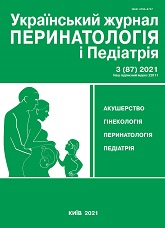Assessment of the state of personal and situational anxiety and indicators of stress-implementing and stress-limiting systems of the organism as marker efficiency the antenatal preparation
DOI:
https://doi.org/10.15574/PP.2021.87.17Keywords:
labor, prenatal preparation, transcranial electrostimulation, pain threshold, anesthesia, partnership laborAbstract
As a result of research conducted on the basis of the State Institution «Institute of Pediatrics, Obstetrics and Gynecology named after academician O.M. Lukyanova NAMS of Ukraine», the issue of the transcranial electrostimulation introduction in preparation for partnership labor was shown.
Purpose — to study the features of changes in the state of personal and situational anxiety, stress-implementing and stress-limiting systems of the body in healthy women depending on the method of prenatal training.
Materials and methods. 120 somatically healthy women without severe extragenital and obstetric pathology with a physiological course of singleton pregnancy were examined. In the first group — 45 women set up for partner childbirth, the second group also included 45 patients who underwent a course of transcranial electrical stimulation (TES) of mesodiencephalic structures of the brain in comprehensive preparation for partner childbirth. The control group included 30 women who did not receive prenatal training, did not have individual support in childbirth and were tuned to traditional methods of pain relief as needed.
Results. Following the results of the determination of pain rate in the dynamic of the TES procedure, a progressive growth of the pain tolerance threshold was recorded with the subsequent stabilization of this value after the 5th procedure of electrical stimulation. Methods of psychophysical preparation for childbirth using transcranial electrostimulation and partner support made it possible to reduce medical induced pain relief during childbirth, which is what the data we obtained indicate.
Conclusions. The use of TES in complex prenatal preparation for partner labor allows to achieve and maintain a stable psycho-emotional adaptation of pregnant women and increases the tolerance of the consonant to labor pain without additional medication load, which helps to make more physiological course of labor.
The research was carried out in accordance with the principles of the Helsinki declaration. The study protocol was approved by the Local ethics committee of the participating institution. The informed consent of the patient was obtained for conducting the studies.
No conflict of interest was declared by the authors.
References
Boyko VI, Kobulezkay NA. (2015). Preventive maintenance of anomalies of patrimonial activity and perinatal pathologies with use of partner labours. Health of woman. 7: 34-36.
Ishchenko AI, Demenina NK. (2019). Dynamics of Operative Delivery in Modern Obstetrics (literature review). Perinatologiya i pediatriya. 2 (78): 54-57. https://doi.org/10.15574/PP.2019.78.54
Kachalina TS, Lokhina EV. (2013). Application of new methods of psychological support of pregnancy and psychological preparation for childbirth. Medical almanac. 6 (30): 37-41.
Manukhin IB, Silaev KA. (2016). The role of psychoprophylactic preparation of pregnant women for childbirth. Russian Bulletin of Obstetrician-Gynecologist. 16 (6): 9-13. https://doi.org/10.17116/rosakush20161669-13
Medvedev MV, Davydova YuV. (2016). Prevention of perinatal loss: towards personalized medicine. 1 (65): 59-65. Perinatologiya i pediatriya. doi: 10.15574/PP.2016.65.59.
Pupyshev AG. (2002). The use of transcranial electrostimulation of the brain for pain relief in labor: author. dis. Cand. honey. sciences. Volgograd: 32.
Reynolds RM, Labad J, Buss C, Ghaemmaghami P. (2013, Sep). Transmitting biological effects of gtressin utero: implications for mother and off sping. Psychoneuro endocrinology. 38: 1843. https://doi.org/10.1016/j.psyneuen.2013.05.018; PMid:23810315
Romanzi LJ. (2014, Oct 1). Natural Childbirth a global perspectivevirtual Mentor. 16 (10): 835-844. https://doi.org/10.1001/virtualmentor.2014.16.01.ecas2-1401; PMid:24433656
Simkin P, Bolding A. (2013). Update on nonpharmacologic approaches to relieve labor pain and prevent suffering. Journal of midwifery-womens Health. 49 (6): 489-504. https://doi.org/10.1016/S1526-9523(04)00355-1
Syusyuka VG. (2016). Estimation of influence of introduced program of medical and psychological correction of psychoemotional disadaptation of pregnant women on perinatal consequences of their delivery. Perinatologiya i pediatriya. 3 (67): 43-48. https://doi.org/10.15574/PP.2016.67.43
Temkina AA. (2014). Medicalization of Reproduction and Childbirth: The Struggle for Control. Journal of Social Policy Research. 12 (3): 312-316.
Vdovichenko SJ. (2015). Influence of partner sorts on character of patrimonial activity at women at first - and repetite-labours. Health of woman. 7 (103): 32-33.
Vdovichenko SJ. (2015). Role of psychological estimations of married couples at carrying out of partner labours. Health of woman. 2 (98): 87-89.
Vdovichenko SYu. (2017). Prophylaxis of obstetric and perinatal pathology at application of the family focused technologies during pregnancy and labors. Health of woman. 3 (119): 79-81. https://doi.org/10.15574/HW.2017.119.79
Zhabchenko IA. (2020). Suchasni pidkhody do profilaktyky akusherskoho travmatyzmu ta yoho naslidkiv. Medychni aspekty zdorov'ia zhinky. 1: 5-10.
Downloads
Published
Issue
Section
License
The policy of the Journal “Ukrainian Journal of Perinatology and Pediatrics” is compatible with the vast majority of funders' of open access and self-archiving policies. The journal provides immediate open access route being convinced that everyone – not only scientists - can benefit from research results, and publishes articles exclusively under open access distribution, with a Creative Commons Attribution-Noncommercial 4.0 international license(СС BY-NC).
Authors transfer the copyright to the Journal “MODERN PEDIATRICS. UKRAINE” when the manuscript is accepted for publication. Authors declare that this manuscript has not been published nor is under simultaneous consideration for publication elsewhere. After publication, the articles become freely available on-line to the public.
Readers have the right to use, distribute, and reproduce articles in any medium, provided the articles and the journal are properly cited.
The use of published materials for commercial purposes is strongly prohibited.

